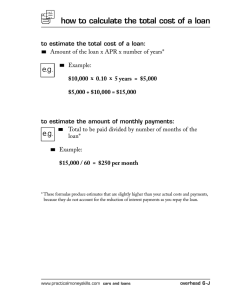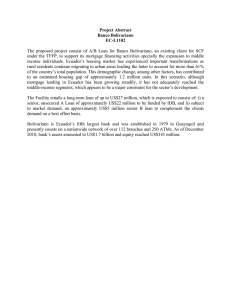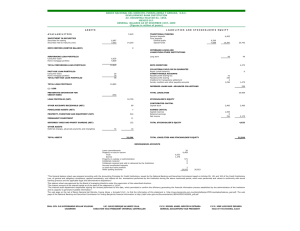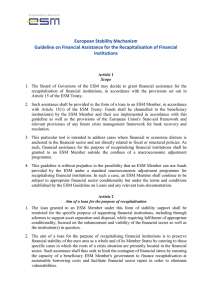EFSF Guideline on Recapitalisation of Financial Institutions (FIs) via
Anuncio
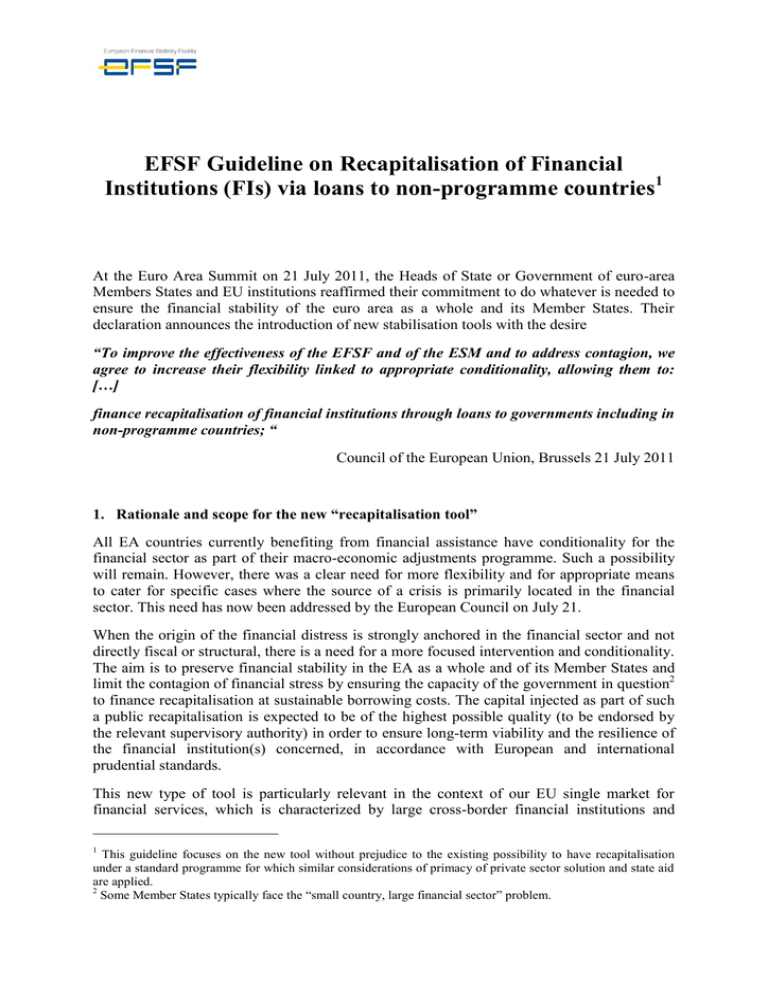
EFSF Guideline on Recapitalisation of Financial Institutions (FIs) via loans to non-programme countries1 At the Euro Area Summit on 21 July 2011, the Heads of State or Government of euro-area Members States and EU institutions reaffirmed their commitment to do whatever is needed to ensure the financial stability of the euro area as a whole and its Member States. Their declaration announces the introduction of new stabilisation tools with the desire “To improve the effectiveness of the EFSF and of the ESM and to address contagion, we agree to increase their flexibility linked to appropriate conditionality, allowing them to: […] finance recapitalisation of financial institutions through loans to governments including in non-programme countries; “ Council of the European Union, Brussels 21 July 2011 1. Rationale and scope for the new “recapitalisation tool” All EA countries currently benefiting from financial assistance have conditionality for the financial sector as part of their macro-economic adjustments programme. Such a possibility will remain. However, there was a clear need for more flexibility and for appropriate means to cater for specific cases where the source of a crisis is primarily located in the financial sector. This need has now been addressed by the European Council on July 21. When the origin of the financial distress is strongly anchored in the financial sector and not directly fiscal or structural, there is a need for a more focused intervention and conditionality. The aim is to preserve financial stability in the EA as a whole and of its Member States and limit the contagion of financial stress by ensuring the capacity of the government in question2 to finance recapitalisation at sustainable borrowing costs. The capital injected as part of such a public recapitalisation is expected to be of the highest possible quality (to be endorsed by the relevant supervisory authority) in order to ensure long-term viability and the resilience of the financial institution(s) concerned, in accordance with European and international prudential standards. This new type of tool is particularly relevant in the context of our EU single market for financial services, which is characterized by large cross-border financial institutions and 1 This guideline focuses on the new tool without prejudice to the existing possibility to have recapitalisation under a standard programme for which similar considerations of primacy of private sector solution and state aid are applied. 2 Some Member States typically face the “small country, large financial sector” problem. important channels of contagion. It is even more important in the context of the euro area where deeper economic integration, enhanced coordination of economic policies, and the existence of common sovereign rescue mechanisms require adequate and specific instruments for the financial sector. While the recapitalisation tool does not have the vocation to solve the issue of cross-border bank crisis management in the EU (i.e. no cross-border burden sharing of the rescue aid is taking place), it acknowledges that governments may need a specific financial support in certain cases. The objective of the new instrument is to provide financing to Member States in order to specifically support financial institutions against appropriate conditionality, i.e. not necessarily in the context of a macro-economic adjustment programme but under another more focused form of conditionality. The ability of the beneficiary country to reimburse the loan granted should nevertheless be ensured by a sound macroeconomic policy framework and the existence of an otherwise resilient financial sector. The pricing of this "recapitalisation loan" will be consistent with the pricing of a standard EFSF loan to a beneficiary Member States since the latter will remain the ultimate liable counterparty. 2. Eligibility conditions The following pecking-order in the financing of the recapitalisation should be respected. First, before considering a public intervention, the primacy of private sector contributions should be reasserted. Recapitalisation of a financial institution should be first and foremost financed by its shareholders, as the owners and those ultimately responsible for past business decisions3. Second, should the privately financed solutions be ineffectual, it would be the primary responsibility of the national government concerned to assure financial stability and limit contagion, possibly through national schemes for the recapitalisation or resolution of the financial institutions in distress (deposit guarantee scheme-type or resolution frameworks). Nevertheless, experience has shown that some governments may not have large enough resources, especially where the size of the financial sector is large relative to the size of the economy. In these cases, the new tool may serve as the last-resort instrument to preserve financial stability. A candidate for recapitalisation will have to be a distressed financial institution systemically relevant or posing a threat to financial stability. Possible criteria for the assessment of the systemic dimension could – inter alia – reflect the FSB discussions and future EU regulatory framework on SIFIs where size, interconnectedness and substitutability would be considered as relevant indicators. In addition, a beneficiary country will have to demonstrate that it has a sound fiscal policy record, such as the respect of its SGP commitments4, and sufficient capacity to reimburse the EFSF loan even in cases where such a beneficiary country would not be able to recover the capital injected according to the timing agreed in the state-aid decision. The size of the loan should not threaten the fiscal position of the beneficiary Member State. 3 In the future, special crisis management and resolution intervention powers for national supervisors could expand the possibilities for the private contributions via mechanisms such as bailing-in bondholders. 4 Countries under excessive deficit procedure would still be eligible for this recapitalisation loan, provided they fully abide by the various Council decisions and recommendations aiming at ensuring a smooth and accelerated correction of their excessive deficit. 2 These eligibility conditions will be assessed upfront and the risks for financial stability and contagion confirmed by an independent assessment underpinned by a stress testing of relevant financial institutions in the respective country (see also section on procedure). As financial markets may be erratic and contagion spreads fast between countries, and different segments of the markets, the eligibility conditions will have to be verified within a short time span and allow for a timely conclusion of the decision-making process in order to ensure the effectiveness of the instrument. This was explicitly emphasised in the HoSG declaration. 3. Conditionality attached to the "recapitalisation loan" The focus of the EFSF funded support should be on financial sector repair, with planned restructuring/resolution of financial institutions as the sine qua non condition for EFSF assistance for recapitalisation. Similarly to the assessment of the eligibility conditions, the identification of the appropriate conditionality may have to take place within a short time span. Overall, two sets of conditions could be foreseen: EU law related, institution-specific conditionality5 The vast majority of recapitalisations provided by governments to support ailing financial institutions are considered as state aid and fall under the scrutiny of the European Commission, irrespective of whether the governments have financed these recapitalisations through EFSF loans or by other means. The first conditionality for these recapitalisations will therefore be to comply with European state-aid rules, which is a legal constraint imposed by the TFEU. The Commission will be responsible for assessing this compliance under existing procedures. It should be noted that this conditionality is institution-specific. In accordance with EU state-aid rules, the publicly funded recapitalisation is designed in such a way as to provide incentives for early exit (and a swift return to market financing) by means of appropriate remuneration and redemption conditions. Moreover, as a rule, every beneficiary institution will be subject to a restructuring plan commensurate with the extent of the financial support received. The objectives of these rules are to limit, to the maximum, the distortion of competition while at the same time ensuring the long-term viability of the aided institution, all while keeping in mind the ultimate goal of preserving financial stability. In order to ensure consistency between the conditionality accompanying the loan and the one imposed in the context of the state-aid rules, the Commission will keep the EFSF informed of any relevant developments during the state-aid process. Where appropriate, additional conditionality could draw from the future EU bank crisis resolution framework, which will be proposed by the Commission after summer. In particular, such a conditionality could include requirements to enhance the supervisory toolbox in the three crucial phases of crisis management identified (preparation, early intervention and resolution) such as recovery and resolution plans, early intervention tools for supervisory authorities, asset separation tools, bail-in tools. 5 This part of the conditionality is consistent and similar to the current practices in the programme countries or in any state aid decisions taken for the rescues in the financial sector since the beginning of the crisis. 3 Finally, there must be an obligation for the beneficiary country to recover the bank rescue aid according to agreed procedures and to reimburse the loan in case of non-compliance with European state-aid rules, while ensuring appropriate financial stability conditions. Horizontal conditionality including structural reform of the domestic financial sector Additional conditionality should also be envisaged in the domains of financial supervision, corporate governance and domestic laws relating to restructuring/resolution in line with the forthcoming Commission proposal on crisis prevention, management and resolution and following the agreement in the Pact for the Euro on 11th March 2011. Technical assistance by other National Supervisory Authorities to the domestic authorities and monitoring by the relevant ESAs could also be envisaged. Lastly, the opening of the domestic market to foreign ownership/entry could also be required. 4. Use of EFSF targeted loans as an instrument The financing would be channelled through the State. As the EFSF's main activity consists of granting loans to euro-area Member States, the newly introduced targeted loan will draw upon existing infrastructure. However, changes to loan documentation and pricing may be needed taking into account the loan's specific purpose as the EFSF will grant a targeted loan without necessarily having recourse to a negotiated programme. This means also that part of the conditionality may have to be included in the loan documentation. In any case, the EFSF will have to be able to verify that its counterparty under the loan contract behaves in line with the purpose of the loan and that the EFSF itself thus operates in line with its mandate. 5. Institutional and procedural issues All procedures related to EFSF support in the form of a targeted loan will have to ensure that the actual use of support by a beneficiary Member State is in line with the underlying objectives of this new recapitalisation tool and the granting of support. At the same time, the request for and control of this instrument needs to be 'lighter' than in the case of a regular program in order to increase the speed of funding as well as to reflect the sectorial nature of the loan. In all cases, compliance with EU and national law is a prerequisite. 1. The initiative to request support shall come from the government, which will indicate the institution(s) in distress, which eventually will receive the loan. This loan will be channelled through the national authorities, which ultimately bear the liability of the loan. Institutions in need of recapitalisation should not directly approach the EFSF. The request shall be made to the chairman of the Eurogroup. 2. An independent assessment verifying the eligibility conditions should be provided, including an assessment of (1) the origin and degree of distress of the concerned financial institution(s), (2) the need to urgently restore its (their) long-run viability/resilience, (3) its (their) systemic relevance, the extent of the threat to financial stability and the risks of contagion, (4) the respect of the pecking-order for 4 the provision of the support and (5) the impact of the loan on the fiscal situation of the Member State thereby under which the negotiating for the loan and the conditionality will start. This joint assessment should be provided by the Commission, in liaison with the ECB, and where appropriate with the relevant ESA(s) (EBA, ESMA, EIOPA. 3. Beneficiary governments, in close cooperation with the relevant national supervisory authority, will indicate the benefitting financial institution(s) and the most appropriate recapitalisation instrument. The amount of capital needed should be derived by conducting a stress test of the institution(s) concerned and of all other relevant financial institutions in the beneficiary Member State. In order to accommodate timing constraint, this assessment could be conducted in two stages to allow for a first estimate, to be confirmed by a more comprehensive analysis at a later stage. The stress testing will have to be conducted by the national supervisor, involving the relevant ESA(s) (EBA, ESMA, EIOPA) and national experts from supervisory authorities of other member states. 4. In parallel with the decision process of the EFSF, negotiation of the conditionality of the public aid imposed by the EU state-aid rules, including a restructuring plan, will be conducted at national level with the European Commission. State-aid approval by the Commission (DG COMP) must be ensured. The financial institution(s) concerned commit to implement the measures of the plan. 5. The decision to grant the loan shall be done by the Eurogroup based on a proposal by EFSF. The conditions attached to the loan must include institution-specific (without prejudice to the state-aid decision(s) and with appropriate reference to its (their) content) and country-specific horizontal elements. These conditions will be reported in a Memorandum of Understanding (MoU) prepared by the Commission, in liaison with the ECB, and where appropriate with the relevant ESAs. 6. The preparation of the documentation, the monitoring of all financial and contractual aspects of the loan will be conducted by the EFSF. The EWG/Board of Directors will decide, by mutual agreement and on a proposal from the EFSF after having received a monitoring report from the European Commission prepared in liaison with the ECB and, where appropriate other relevant ESAs, on the disbursement of the possible tranches. The terms of (early) repayment of a loan will require EFSF agreement. A beneficiary country will have to adhere, at least until the loan is repaid, to the conditionality defined as part of the decision to provide a recapitalisation loan and will be subject to continuous monitoring. Any realized profit emerging from the recapitalisation, based on an ex post cost-benefit analysis, should be used for the early repayment of the loan upon the request of EFSF, where the Member State concerned would abstain from the vote. Monitoring of compliance with institution-specific conditionality to ensure the compliance with the state-aid decision, will be conducted by the European Commission. Other conditionality elements will be monitored by the Commission in liaison with ECB and the relevant ESA(s) (EBA, ESMA, EIOPA). In particular, these institutions must be granted the right to conduct on-site inspections in any beneficiary financial institutions in order to monitor compliance with the conditions. They have to be authorized to involve other relevant experts, such as external auditors or monitoring trustees. Continuous monitoring by 5 and reporting to the EFSF will also be necessary to ensure that, as provider of the financial support, the EFSF is up-to-date on all relevant, loan-related developments. An additional assessment of the quality of national supervisory practices by the IMF, possibly by means of an FSAP or ROSC exercise, will be actively sought by the beneficiary Member States in the period of implementation of the financial assistance. 6
